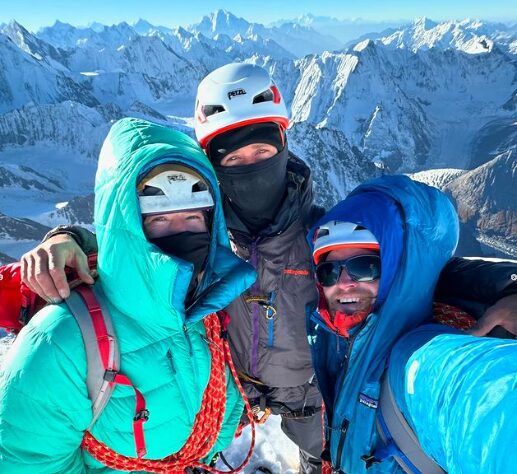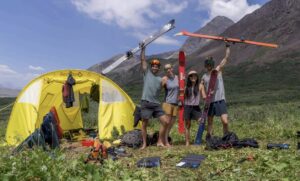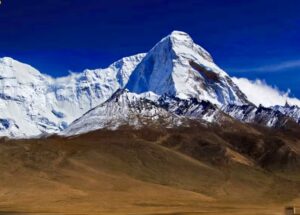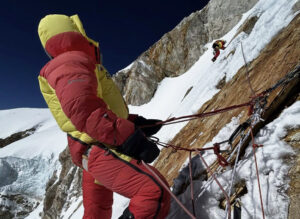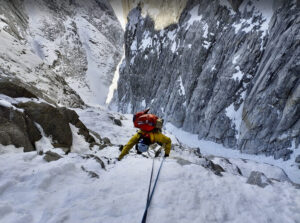The Piolets d’Or jury had a particularly difficult task this year, they noted, to pick only three among the many worthwhile climbs. Two of the three awards went to American teams.
Two climbs took place in the Karakoram and another in western Nepal. All three were traverses.
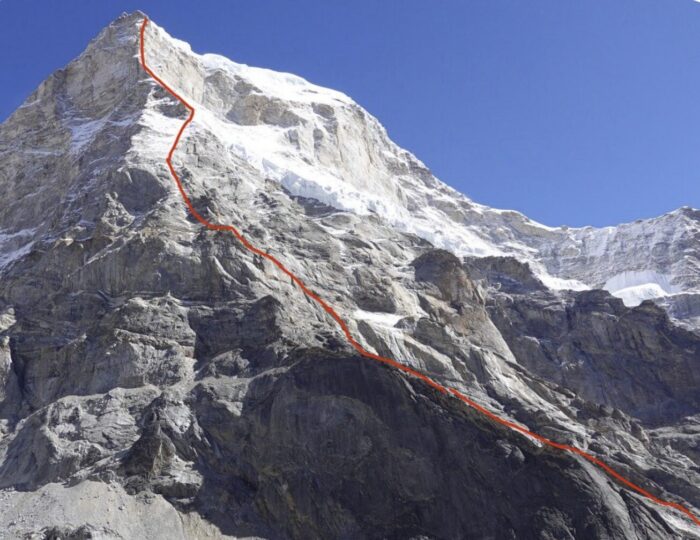
The new line on Kaqur Kangri. Photo: Spencer Gray
The surprise: Kaqur Kangri (6,859m)
Two of the climbs were also among ExplorersWeb’s Top Expeditions of 2024. The third one flew under our radar. This was the first ascent of the southwest arete of 6,859m Kaqur Kangri, in western Nepal on the Tibetan border. Spencer Gray, Ryan Griffiths, and Matt Zia of the U.S. had only seen a photo of the upper part of the ridge, so they had to manage the lower half without knowing anything about it.
The trio climbed the 1,670m ridge to the summit along a route they assessed as 5.10 A0 M7 WI5. After a bivouac on the upper part, the team summited, then traversed the peak and descended down the previously unclimbed northwest ridge. The jury members said theirs was one of the hardest routes ever climbed in remote western Nepal.
The nearly 8,000m Gasherbrum III (7,952m)
Tom Livingstone of the UK and Ales Cesen of Slovenia bagged the first ascent of the west ridge of the highly difficult — and high — Gasherbrum III in the heart of the Karakoram. Then they traversed down the east face and linked it with the normal route of neighboring Gasherbrum II.
Gasherbrum III had a long history of attempts but only two previous ascents, by Alberto Inurrategi and Jon Beloki of Spain’s Basque Country in 2004, and the first ascent in 1975 by members of a Polish expedition — Wanda Rutkiewicz, Alison Chadwick-Onyszkiewicz, Janusz Onyszkiewicz and Krzysztof Zdzitowiecki. Cesen and Livingstone had also tried once before, in 2022.
Ales Cesen and Tom Livingstone received another Piolet d’Or in 2019 for the south face of Latok. And Cesen has a third Piolet, in 2015 for the north face of Hagshu, with Marko Prezlj and Luka Lindic.
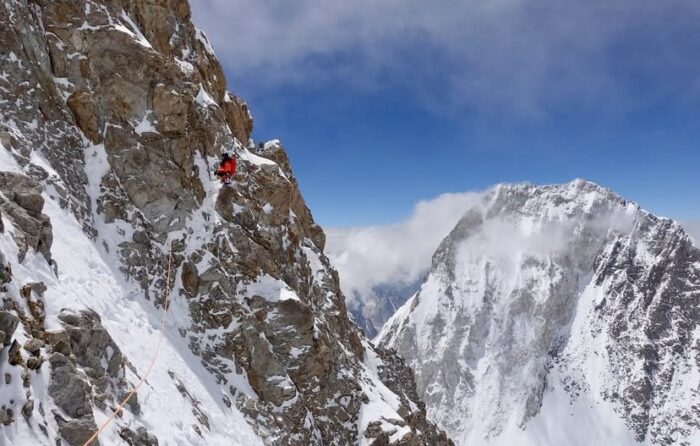
On Gasherbrum III. Photo: Livingstone/Cesen
For this 2024 effort, the pair made three acclimatization climbs, including a night at 7,000m. Then they started the summit push, according to the Piolets d’Or press team:
They left base camp on July 31, and two days later regained the 7,000m camp below the start of the west ridge. The next morning, they set off up the ridge, stopping for the first night a little below 7,500m, and on the second at around 7,800m.
Unable to erect a tent at the upper site, they were forced into an open sitting bivouac. They then bypassed the headwall via difficult climbing, possibly up to M6 on one pitch, summited, then descended the original route on the far side of the mountain. After a night at Camp 4 (7,400m) on the standard route to Gasherbrum II, they reached base camp on August 6.
The jury highlighted the significant height of the mountain and “the light alpine style of the two-person team, as well as “the logical descent made on the opposite side of the mountain.”
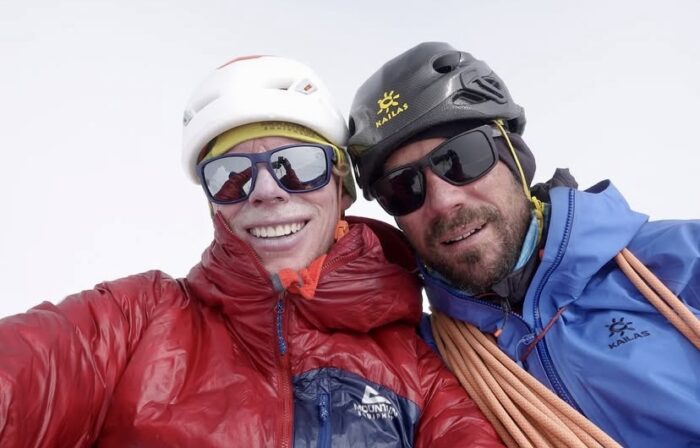
Tom Livingstone, left, and Ales Cesen on the summit of Gasherbrum III. Photo: Livingstone/Cesen
They called their route Edge of Entropy. ExplorersWeb ranked their effort as one of the Best Expeditions of 2024.
Yashkuk Sar (6,667m)
The third awarded climb was the first ascent of Yashkuk Sar in the Karakoram’s Batura Muztagh. Americans Dane Steadman, August Franzen, and Cody Winckler climbed the north pillar and descended via the upper west face and lower north face. Their 2,000m line, called Tiger Lily Buttress, featured difficulties up to AI5+ M6 A0.
Their acclimatization also included a new route up the southeast side of 6,240m Sax Sar.
Steadman described the climb to ExplorersWeb at the time. It included two days of snow-and-ice climbing up the steep north pillar and two nights on vertiginous bivouacs.
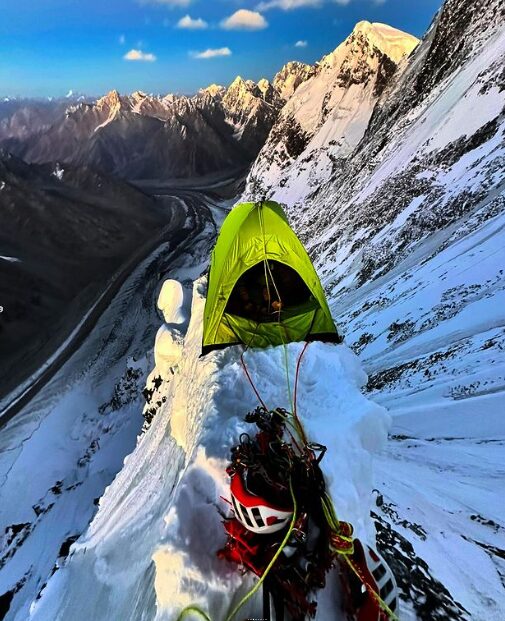
The spectacular but precarious second bivouac. Photo: Dane Steadman
From that point, finding a route up was risky, as falling snow swept the headwall.
“We did rappel down off the ridge to the other side, the only aid of the route,” Steadman recalled. “Then [we went] up an ice arete for a couple of hundred meters to the base of the headwall and finished the day with two tricky pitches up snowy gneiss that was either smooth and compact or heavily fractured.”
The final day was even harder, on mixed terrain up to M6, then two traversing pitches through a forest of snow mushrooms and along a marble band to the crux ice pitch, an overhanging AI5+, that led to the top of the headwall,” Steadman recalled.
The team reached the summit ridge that day, but deep snow forced them to stop for another bivy before topping out the following morning. Then they rappelled 600m down a couloir on the west face, before traversing back over the west ridge to down climb and rappel the lower 1,000m of the north face.
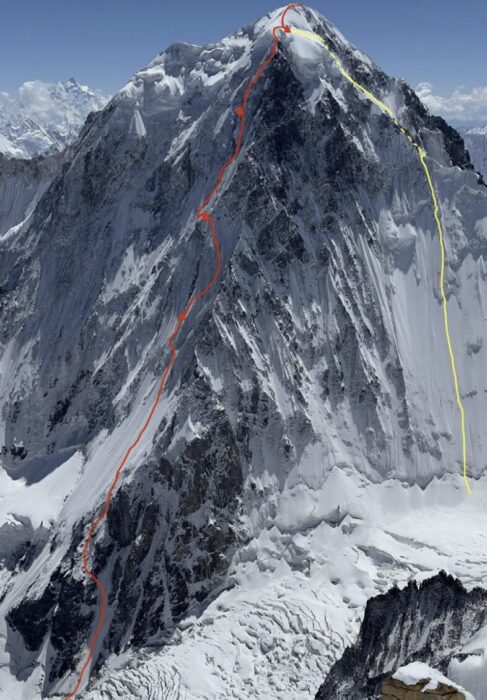
Ascent and descent route of Yashkuk Sar. Photo: Dane Steadman
The jury appreciated the commitment to the climb, and the “spirit of alpinism of the young team” who found the peak on Google Earth.
